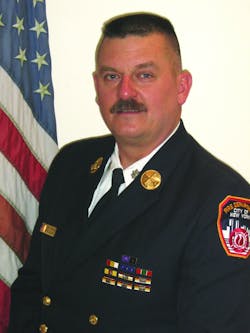The Fire Scene: Sewing a Grape
Now that I have your attention with the odd-sounding headline, let me explain. I’m watching a medical show on TV and a scene opens where several emergency room doctors are sitting in some type of lab. On the lab table is a bowl of grapes. While these doctors talk about an unrelated issue, one of them is literally sewing a grape. (Actually, he is stitching a grape – you know, the stitches you get when you go to the emergency room with a laceration.)
Now, these are not new, young doctors, but experienced emergency room physicians. Even with all their training and experience, these senior doctors are practicing – practicing something they do almost every day. Are you practicing? Practice in the fire service is called training.
I have said this before and I will certainly say it again: If you are a career fire officer and you are not conducting some type of training every time you work a shift in the firehouse, you are not doing your job. This is not up for discussion or debate. Training is the most important activity firefighters can be involved in. It is the activity that most directly and most effectively improves the performance and safety of firefighters working in the field.
There are several types of training activities you can provide. Let’s take a look at what type and frequency of training is appropriate for today’s firefighters:
1. Kitchen-table discussions. There are numerous times a day when firefighters and officers gather around the kitchen table. Sometimes it’s for a meal or a coffee break, but whatever the reason for gathering, it is a great opportunity for a short training discussion. You don’t even have to identify it as a training event; just bring up a recent fire or other operation and start a discussion about how well things went or what improvements could be made. Fifteen or 20 minutes later, when the conversation is over, each of the involved firefighters will have learned a lesson or two.
2. Daily company drills. Regardless of any other activities or plans, a regular company training drill should occur. This should not be a random, “Oh, what should we drill on today” type of event. It should be a planned and thought-through exercise. As a young lieutenant, I had a small spiral notebook with dozens of drill subjects and training information that I would review at the start of each tour. I would select a topic and an activity for that day’s drill and let the firefighters know right after the beginning of the shift so they could prepare, study up or just know what we would be discussed later that shift. This drill can be held on the apparatus floor, on the roof of the firehouse or out at a commercial building in your response area. Wherever it occurs, it should be a solid lesson on a tool, tactic or concept.
3. Hands-on training. Some of our training events will be discussions in the kitchen, others will be around the rig on the apparatus floor, but conduct some hands-on training on a regular basis. It doesn’t have to be a gigantic event conducted in an acquired structure, but it must involve firefighters handling equipment, fully geared up as if they were actually operating.
Self-contained breathing apparatus (SCBA) drills in particular lend themselves to great hands-on evolutions. Firefighter survival skills such as wall breaching, window escape slide and the ladder bail are also great skills to practice during hands on exercises. Don’t be afraid to research training props that can be easily constructed and then used right in the firehouse. I have seen props constructed for roof cutting, forcible entry, through-the-wall escape and hoseline stretching. Use your imagination.
4. Cross training. Cross training is the process of making firefighters proficient in all aspects of firefighting. Some departments assign firefighters to specific units, such as an engine, ladder, squad, rescue or ambulance. In these departments, a firefighter may work every shift in that company performing related work. In other departments, firefighters are rotated every shift, week or month from the engine to the squad or ambulance, etc.
Regardless of the work assignments your firefighters have, make sure every firefighter has a baseline level of skill. For firefighters assigned primarily to ladder companies, engine company drills and apparatus familiarization need to occur. The same can be said for engine firefighters who need to know basic hand tool names and uses, portable ladder skills and search and rescue tactics. The goal is for every firefighter to be able to respond on every apparatus and know what he or she is doing.
This is just a primer on different ways an officer can think about, plan for and conduct training. If you are already performing some of these activities, great; if some of them are new to you, give them a try, you’ve got everything to lose.
